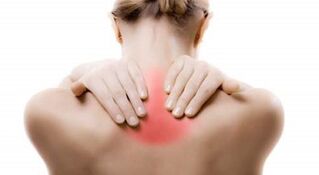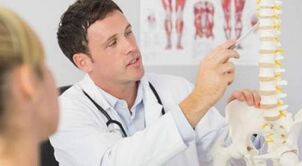
Discomfort in any part of the spine can limit mobility, reduce performance and severely impair quality of life. Back pain can have multiple causes and is not always related to bone and joint structure. To determine the cause of the problem, you must see a doctor.
Types of back pain
There are two reasons for this syndrome. In the first case, back pain is caused by pathology of the musculoskeletal system. It includes bones, joints and muscle tissue, ligaments and tendons. The second possible cause is that severe pain in the right or left back is a disease of internal organs. The inflammatory process is usually accompanied by compression of nerve roots, which causes the above-mentioned problems.
Back pain caused by spinal diseases
An obvious cause of discomfort is damage to the musculoskeletal system. If the back is injured between the shoulder blades, neck or lower back, attention should be paid to the intensity, duration, and nature of the symptoms.
In spinal diseases, diseases of nearby muscles, joints and ligaments, pain has the following characteristics:
- Strong-If you don’t have painkillers or anti-inflammatory drugs, it’s hard to tolerate discomfort. It feels very obvious, limiting mobility and flexibility.
- Paroxysmal-occurs in a certain position of the body or during certain movements. Constant back injuries are very rare.
- Sharp-Sharp, stabbed, shot. It feels similar to sudden mechanical damage.
Back pain caused by visceral diseases
Puffiness, inflammation, and suppuration will increase the volume of soft tissue. This can cause nearby nerve roots and ends to be squeezed, causing pain in the left shoulder blade or lower right of the neck, lower back, or tailbone. Compared with the pathology of the musculoskeletal system, the symptoms presented are less obvious. Even if the entire back is injured, the discomfort can be tolerated. They are permanent, sometimes permanent.
Pain may be specific to this:
- pain;
- pull;
- Press;
- Stupid.
Why did you hurt your back?

After processing the characteristics and severity of the indicated trait, it is important to determine its location. It must be understood that the exact cause of back pain cannot be determined by itself. In order to make a correct diagnosis, thorough medical examination, laboratory and instrumental research will be required. For example, pain under the right shoulder blade can cause osteochondrosis and lung damage on this side of the body. Due to the multifactorial nature of the described problem, self-medication is dangerous.
The back is injured above the back bone of the shoulder
Discomfort, stiffness and poor mobility in the shoulder belt and neck area are the characteristics of osteochondrosis. Depending on the location of the strangulated nerve root, back pain may be felt on the left or right side.
In addition to osteochondrosis, pathological symptoms also occur due to the following reasons:
- Stretch;
- Muscle overload;
- Osteoarthritis;
- Fibromyalgia;
- Ankylosing spondylitis;
- Spinal stenosis;
- Myofascial syndrome;
- Rheumatoid and psoriatic arthritis;
- Polymyalgia;
- Intervertebral hernia;
- neck injury;
- Osteomyelitis;
- Tuberculosis;
- Acute thyroiditis;
- Any quality of tumor, its metastasis;
- Mechanical damage to the spine;
- Visceral diseases (kidney, brain, heart, intestine, esophagus, etc. );
- Lymphadenitis;
- Shingles;
- Meningitis.
Shoulder blade bone and back injury
The central part of the spine is the most common place for stitching, pulling, and cutting. In this case, it is important to figure out the side that feels uncomfortable.
Pain below the right shoulder blade may occur for the following reasons:
- Biliary liver colic;
- Abscess under phr;
- Abnormal renal function;
- Cholecystitis;
- Tuberculosis.
If the back is injured in the left shoulder blade area, the following pathology is suspected:
- Psychological problems;
- Ulcerative gastritis;
- Diseases of the esophagus;
- Myocardial infarction;
- Inflammation of the pancreas;
- Renal colic.
Back pain in the middle shoulder blade area usually indicates musculoskeletal diseases:
- Intervertebral disc herniation;
- Osteochondrosis;
- Shoulder cap bone injury; Spine curvature
- Spondyloarthropathy;
- Intercostal neuralgia;
- wing ery bone shoulder; bone;
- Herniated disc;
- Muscle cramps;
- Tumor, shoulder osteomyelitis.

Less frequent internal organ disease pain in the center of the back:
- Hepatitis;
- Pulmonary respiratory system disease;
- Cholecystitis;
- Biliary dyskinesia;
- Duodenal ulcer;
- Ischemic heart disease;
- Angina.
Back pain in the lumbar region
The display part of the spine has the largest load, so it is easy to damage it. Severe back pain mainly occurs after strenuous exercise or physical exercise. It gradually disappeared while resting on its own.
Back pain in the waist area may be caused by the following reasons:
- Rupture and deformation of the intervertebral disc;
- Fracture of one or more vertebrae;
- Inflammation of the joint capsule;
- Osteochondrosis;
- Fibrositis; Rupture of vertebral ligament;
- Compression of nerve endings;
- Osteoporosis; z radiculitis;
- Scoliosis;
- lordosis;
- Arthritis and arthritis;
- Spinal tumors; Diseases of the genitourinary system;
- Intestinal and renal pathology;
- Wright syndrome;
- Epidural abscess; Brucellosis of the intervertebral disc;
- The beginning of the menstrual cycle;
- Pancreatitis;
- Urolithiasis;
- Pyelonephritis;
- Cystitis, etc.
Lower back pain below the waist
Discomfort in the coccyx region rarely occurs alone, and is accompanied by discomfort in the adjacent parts of the spine.
The causes of pain in the lower back are as follows:
- Fracture of the tailbone;
- Scoliosis;
- Ligaments, muscle sprains;
- Arthropathy;
- stand out;
- Hernia;
- lordosis;
- Osteochondrosis;
- Ankylosing spondylitis;
- radiculitis;
- Intestinal obstruction;
- Inflammation of the appendix;
- Kidney pathology;
- Chronic constipation;
- Gastritis;
- Pyelonephritis;
- Hepatitis;
- Cystitis;
- pregnancy;
- Menstruation;
- Orgasm;
- Urolithiasis;
- Ovarian cyst;
- Uterine fibroids;
- Inflammation of the attachment;
- Endometriosis, etc.
What if you have a back injury?
First of all, it is important to understand that it is impossible to independently determine the true cause of discomfort. The diagnosis and treatment of back pain is the prerogative of qualified experts. Before going to the doctor, you can use anti-inflammatory nonsteroidal drugs or painkillers to reduce discomfort. The complete treatment is carried out by an experienced doctor.
If I have back pain, which doctor should I see?

The first specialist recommended by the front desk is a therapist. He will be able to guess the cause of back pain and can take you to a specialist. Depending on the cause, a doctor for the musculoskeletal system or internal organs will treat it.
The following specialists treat severe back pain:
- vertebral orthopedist;
- Neuropathologist (Neurologist);
- Urologist;
- Nephrologist;
- Podiatrist;
- Gynecologist;
- Endocrinologist;
- Cardiologist;
- Gastroenterologist.
Back pain ointment
Topical medications cannot eliminate triggers, but can temporarily relieve discomfort and help patients with effective treatment.
When the back muscles are painful, it is best to use stimulating drugs with warming effect.
For bone, joint and ligament injuries, it is recommended to use anti-inflammatory ointment to treat pain in the lower back, back or neck.
Injection for back and lower back pain
Obvious symptoms can interfere with normal life activities and basic self-service in daily life. To relieve strong or unbearable feelings, you need muscle pain relievers to relieve back pain. Non-steroidal analgesics can relieve inflammation and prevent the sensitivity of nerve receptors, so they can quickly relieve pain.
Back pain exercise
Active physical activity is strictly prohibited during the acute phase of any pathology. Pain under the shoulder cap bone caused by heart disease is not only aggravated by gymnastics, but also complicated by a heart attack. It is important to coordinate any activities or perform these activities with your doctor during recovery.
Upper back and neck movement (repeat 3-5 times):
- Back pressure."Lock" your hands on the back of your head. Press them to try to lower your head. Resist the neck muscles, delay 5-7 seconds.
- Forward pressure.Place your palm on your forehead. Press them and try to move your head back. Resist the neck, linger for 5-7 seconds.
- Side pressure.Press the head alternately with the left and right palms. Resist by tightening the neck, similar to the previous point.
- Circular motion.Place the chin on the chest. Slowly rotate your head from left to right and back, as if rubbing your collarbone.
- turn.Look in one direction, then look in the other, hovering in each position for 5 seconds.
Exercise whether the back is injured in the shoulder area bone area (repeat 5-10 times):
- Press.Lie on your back with your hands folded behind your head and your legs bent on your knees. Take a deep breath. As you exhale, stretch your elbows and knees to the stomach at the same time to bring them into contact.
- Climbers walk.Stand on all fours and move around the room according to the "left hand, right leg" principle. Continue for 10-20 minutes.
- The bridge.Lie down, bend your knees, and stretch your arms along your body. Raise the pelvis up and down.
- Stretching.When standing, your legs should be wider than shoulders. Without bending your back, stretch your chest alternately to your left and right knees.
- Fold.At the position from the previous point, lower your head as much as possible and keep it straight.
Low back pain exercise (10-15 times):
- Embryos.Lie down and bend your knees. Pull them to your chest with your hands and stay for 10 seconds.
- Table of ContentsStand on the ground with your hands on your hips, bending backwards.
- Camel.Bend the spine to a similar position.
- Rotate.The starting position is the same as in the first exercise. Rotate the pelvis and legs left and right without having to lift the lower back from the floor.
- Hunting dog.Go all out. Stretch your right arm forward and straighten your left leg for 5 seconds. Repeat the other side.




























